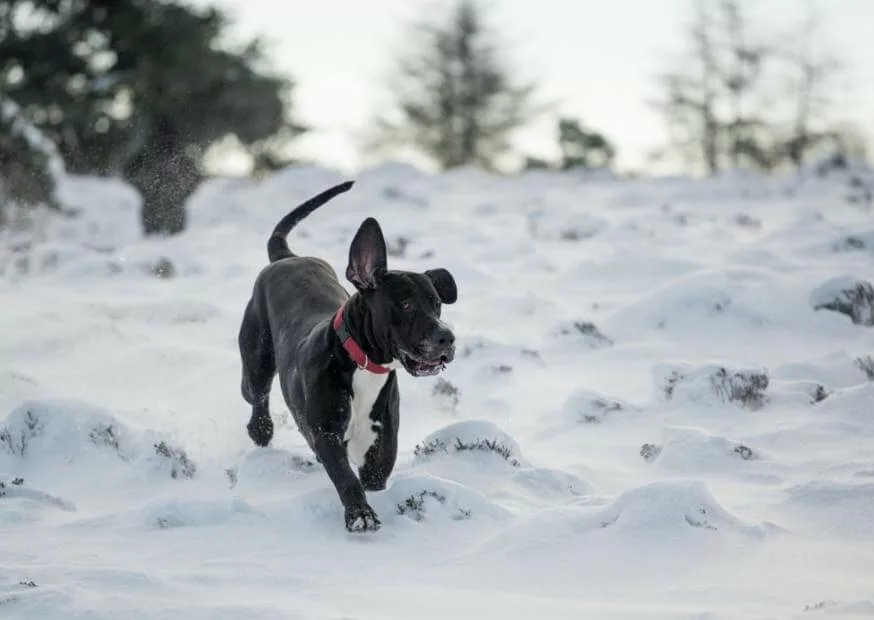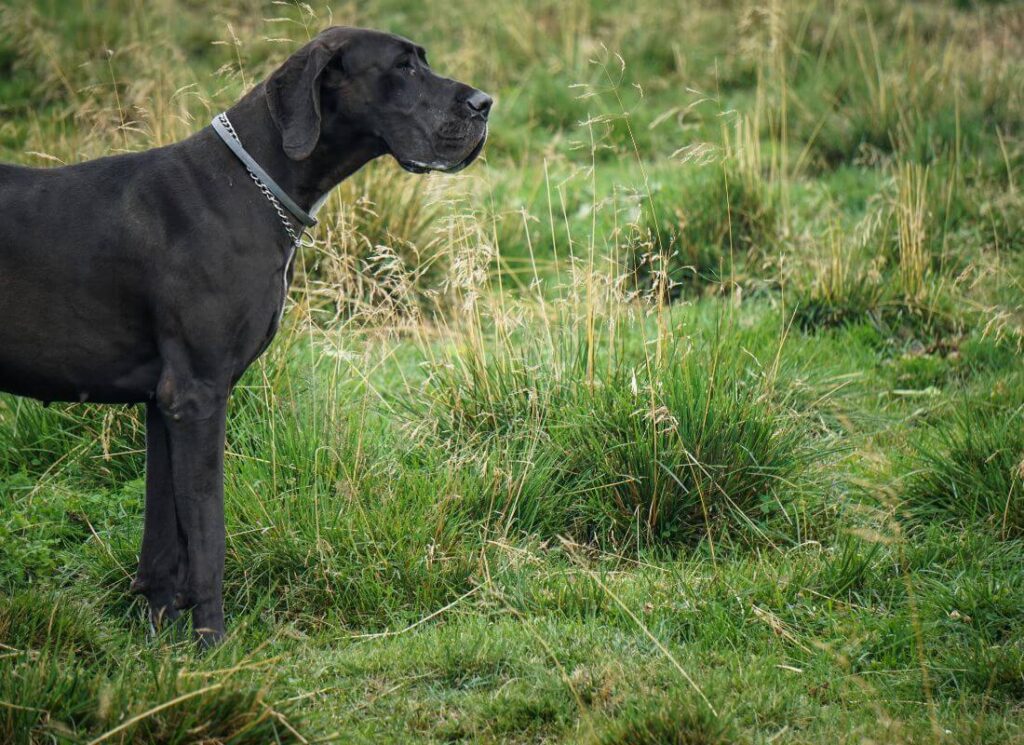If you’ve noticed your Great Dane’s paws suddenly sporting a concerning shade of red and appearing inflamed, it’s completely understandable that you may be concerned! A Great Dane with red paws requires treatment ASAP.
Below we’re including some information to help you sort out your pup’s irritated paws, including:
- Causes of red paws on dogs
- How serious or concerning inflamed, swollen, and red paws might be
- Tips for preventing paw irritation and redness
- Home remedies for treating red paws
- Veterinary information and evidence for treatment and prevention

Great Dane with Red Paws Causes
Because there are many reasons why your Great Dane may have red, irritated paws you must sort out the root cause before applying any treatments. While people online have good intentions, they may lead you down a path of frustration with their recommendations on treating this at home.
Step one is to address the cause, and yes, that may mean a veterinary visit! We recommend documenting all possible factors so that when you see your vet you can bring them as much information as you can.
Here are common causes of red paws on dogs:
Food or Environmental Allergies
Great Danes, like other breeds, can develop allergies to various environmental factors, such as pollen, grass, detergents, or certain foods. Allergic reactions may manifest as redness, swelling, and irritation on the paws.
Do not jump immediately to “chicken allergy”. It’s much more likely to be environmental.
Contact Dermatitis
Exposure to irritants like harsh cleaning chemicals or certain surfaces can lead to contact dermatitis. If your Great Dane frequently walks on surfaces treated with chemicals, it may contribute to red paws.
This is especially true for dogs that are walked in the winter where they may encounter chemicals and salts used to melt ice and provide traction! We recommend utilizing dog boots, like these Hipaw Waterproof dog boots, to prevent the paws from contacting snow and ice salts.
A paw wax such as Musher’s Secret can also help protect paws against snow, ice, and chemicals on the ground!
Bacterial and Fungal Infections of the Paws
Bacterial or fungal infections can cause redness, swelling, and discomfort. It’s essential to examine the paws for any signs of infection, such as unusual odors, pus-filled bumps, or discharge.
Grass seeds and fox tails are common reasons for irritation and swelling in the paws! These seeds get in between the toes and burrow into the skin. It’s very likely that they are deep and must be removed by a veterinarian.
Bacterial and fungal infections (including yeast) can be caused by several factors (including mites, yikes!) and require veterinary treatment.
Do not attempt to treat this at home with “natural home remedies” as in avoiding your veterinarian, you may only prolong the process of healing.
Dry or Cracked Toe Pads
The pads of a Great Dane’s paws can become dry and cracked, especially in extreme weather conditions and in dry climates. This can lead to redness and discomfort. Providing proper paw care, including moisturizing, is crucial.
Musher’s Secret is a fantastic product that will build up over time and continue to protect the paws from snow, ice, chemicals, and allergens.
You might also consider the Natural Dog Company Paw Soother, which is very helpful for minor irritations and dryness!
Red Paws and Mites on Dogs
Mites are a common and often overlooked cause of irritation, redness, and hair loss on dogs and their paws!
They are preventable with veterinary flea & tick prevention, such as Bravecto. Talk to your veterinarian! Internet claims about these products being unsafe are unfounded.
Choosing a veterinary flea, parasite, and tick preventative is a key step towards itch-free skin and robust health in dogs.

How To Treat Red Paws on Dogs
In many cases, the treatment is determined by the cause.
Step One: Consult a Veterinarian. A professional diagnosis will help determine the underlying cause and the most suitable course of action.
Your veterinarian can do testing such as biopsies and skin scrapes which can prove without a doubt what is causing your pup’s discomfort. This step is especially important if your pup’s red paws are oozing, swollen, or smell.
Allergen Management: Identify and manage potential allergens in your Great Dane’s environment. This may involve changes in diet, avoiding specific outdoor areas, or using hypoallergenic grooming products.
When considering food allergies as a potential cause, talk to your veterinarian about a food elimination trial using hydrolyzed protein. This is the gold standard in food allergy testing! Blood, saliva, and serum allergy tests are inaccurate and will be a waste of money and time.
Paw Hygiene: Regularly clean your Great Dane’s paws to remove any potential irritants. Use a mild, pet-friendly cleanser and ensure thorough drying after walks or outdoor activities.
We love the Mud Buster for cleaning paws of mud and allergens after playing outside!
In some cases, a nightly soak in a veterinary chlorhexidine wash or Epsom salt is recommended. Talk to your veterinarian.
Prevent Parasites: Use veterinary flea and tick medications to prevent mites that can irritate your Great Danes’ paws and skin. Tread cautiously with online misinformation about these products being “toxic”!
Mites are disgusting and wreak havoc on your dog’s health. Veterinary flea and tick medications, however, are safe and effective. Your pet will thank you for it!
Moisturize the paws with a veterinarian-recommended paw balm or moisturizer, such as Musher’s Secret. This helps maintain paw health and reduces the risk of irritation. While this won’t necessarily treat an active infection, it can help soothe the skin and prevent future occurrence.
Medications: In cases of infections, your veterinarian may prescribe medications such as mite prevention, antibiotics, or antifungals. Follow the prescribed treatment plan diligently for the best results.
Support your dog’s healthy immune system with a WSAVA-compliant diet, while they undergo treatment.
Prevent Licking: Do not allow your dog to lick their red paws for any reason! Use a crew sock secured properly (not too tight) with a stretchy ACE-type bandage, and supervise your dog. Think of it this way: every time your dog licks their inflamed paw, you have to start all over again with treatment. Do not allow any licking.

Is There a Home Remedy for Treating Red Paws?
Yes, of course!
However, in many cases, home remedies may cause you to chase rainbows. If your pet has a serious underlying infection caused by bacteria, mites, or yeast home remedies may only make it harder for your pet to heal.
There are times when a solid veterinary treatment is needed (including surgery to clean out the infection, as well as antibiotics, antifungals, and mite prevention). Do not let your pup suffer so you can avoid the veterinarian.
However, home remedies can help prevent problems and provide soothing relief for dogs while you wait for more robust treatment (if needed). Here are a few home remedies for red paws:
- Prevent licking with breathable boots and socks
- Keep the paws clean by wiping or washing them after exposure to the outdoors
- Use an Epsom salt soak to reduce irritation
- Keep the nails short to prevent discomfort associated with joint pain that can make your dog chew and bite their feet
- Feed a quality, WSAVA-compliant diet that is well-balanced and bioavailable for their nutritional health, so their body can focus on healing
- Soothing treatments such as coconut oil may be helpful for some pets
If your pet doesn’t improve within 24 hours, it’s time to ditch the home remedies and see your veterinarian!
Leave a comment below! Has your pet had red, irritated paws?



